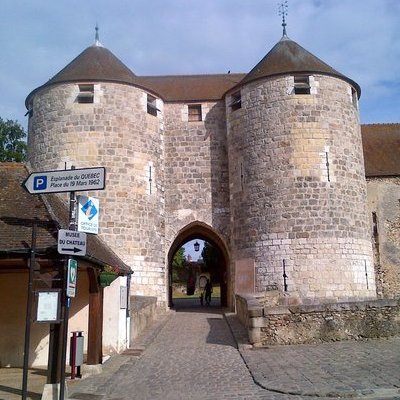
Like us on Facebook
PLACE NAMES


 
|
|
Dourdan
|

|
|
Dourdan is located on the river Orge in the western Essonne. The town is surrounded by the Dourdan's forest.
The origin of the name comes credibly from "Dour" derived of the Celtic root "Dor" which means "water" or "river", the same origin as for the English city of Dover. The radical "dan" could have meant "hill". Dourdan (Dordincum) developed during the Gallo-Roman period as an important center of production of ceramics. In the Middle Ages, it became the residence of Hugh the Great, father of Hugh Capet; he died there in 956.
Dourdan became a royal city in 987, when Hugh Capet was crowned king.
In 1220, King Philip II Augustus of France built a new castle; its most famous owners were: Blanche de Castille, Louis d'Évreux, Jean, duc de Berry, François de Lorraine, duc de Guise, Maximilien de Béthune, duc de Sully, Anne of Austria and the House of Orléans.
Main sights
- Saint-Germain-d'Auxerre Construction of the church began in 1150 and was completed by the end of the 12th century. In 1428, during the Hundred Years' War, its upper part was badly damaged by the troops of the Earl of Salisbury, and it was not restored before the end of the 15th century. It was again damaged by the Huguenots during the Wars of Religion (1562-1598). In 1641, the asymmetric spires were constructed and, in 1689, the chapel dedicated to the Virgin Mary (chapelle de la Vierge) was built, increasing the length of the building from 36 to 50 metres. During the French Revolution of 1789, the church was again damaged. It was turned into a Temple of Reason (Temple de la Raison victorieuse), and also a prison until 1795.
- Château de Dourdan - Built at the request of Philip II Augustus at the beginning of the 13th century in the place of a wooden fortress, it is characteristic of the military architecture of this period. The castle is built on a square pattern, with towers at three of the corners and an isolated donjon at the fourth. The walls are punctuated by towers in the middle of each side, and two, on the east side, flank the gate. A deep stone-lined dry moat follows the outline of the castle. The donjon, the major defensive component of the castle, measures approximately 30 metres in height and 13.6 metres in diameter. It is the typical of the donjons being built by Philip Augustus at this time (e.g. Rouen), and by French nobility through the 13th century.
- The donjon separated from the castle by its own ditch. The conception of the geometric pattern and isolated donjon was similar to that of the castle of the Louvre. A near identical castle is found at Seringes-et-Nesles, Aisne. The castle became the property of Jean de Berry in 1385. There was a siege during the French Wars of Religion, stables were built in this period. Some figures who spent some time there include Jeanne II, Countess of Burgundy, and La Hire, friend of Joan of Arc. The donjon was still a royal prison during the 17th century. There is a museum of local history.
- The market hall - It was built in 1836 and is located in the downtown. It replaced the former hall from the thirteenth century. There is a floor to remind the former hall. The architect was Lucien-Tirte van Clemputte.
 Feel free to Email me any additions or corrections Feel free to Email me any additions or corrections
LINKS AVAILABLE TO YOUR SITE
| | |





